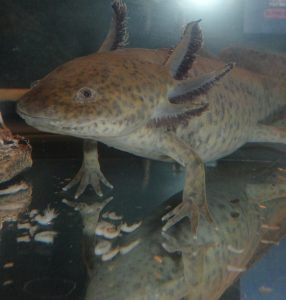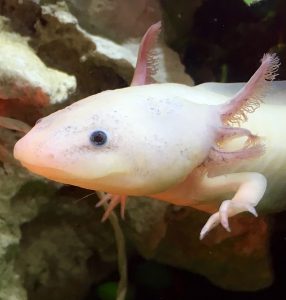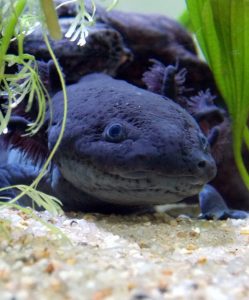Hi there, my name’s Irena and I live on the beautiful island of Crete in the Mediterranean Sea with my lovely and hyperactive dog, Sherlock, and my three cats, Hamlet, Dimitris, and Ebony.
As you can probably guess Ebony is jet black and I consider her to be lucky, not unlucky.
However, we’re not going to talk about my dog or cats today, but we’re going to take a look at the types of Axolotls.
What is an Axolotl?
Perhaps you don’t know what Axolotls are? Well, they are salamanders which are native to Mexico but are now becoming very popular exotic pets.
Their natural habitat is a lake as they like to live in water with very little current. Because of this, an aquarium will be ideal for them.
They are an endangered species in the wild so if you want to get one it will have been bred in captivity.
An interesting fact is that they have both gills and lungs.
However, they spend all their time in water so if you are keeping them as pets you will need a tank filled deeply with water as they don’t need to come out of the water.
They don’t mind being touched, but their skin is very delicate so it’s best to only handle them when you are taking them out of the tank to change their water.
They have, of course, to be put into another container filled with water while you are cleaning their aquarium.
Tips for Taking Care of an Axolotl
Axolotls are hardy and they are great as a first pet because they don’t need too much specialized care.
However, this is not to say that they don’t need looking after and there are a few things you need to do to give them a long and healthy life.
You will need at least a 10-gallon tank for one Axolotl, although 20 gallons is better. In fact, you can even get a bigger tank if you have the room as it will be more interesting for them to swim in a larger area.
Put in rocks, plants, and caves to add to their interest and to give them places to hide if they want some privacy.
Axolotls produce a lot of waste matter so you will need a water filter to keep the water clean.
Because they produce more waste than fish, you will need to change the filter often, probably at least once a week.
Axolotls prefer cooler temperatures and they won’t survive if the temperature is higher than the mid-70s.
You may have to buy a cooler for the tank if you live in a hot climate. Putting a thermometer in their tank is a good idea as you will be able to monitor what the temperature is.
When it comes to food, Axolotls are carnivores and need to eat meat. The best thing to give them is bait worms which you can get from a fishing supply shop.
Don’t put in live fish as they can contaminate the water. Other choices of food include bloodworm cubes, a ball of raw hamburger meat and frozen shrimp. They will love them.
How Many Types of Axolotl are There?
Axolotls are categorized by their color, but there isn’t a definite amount of color variations.
If you find axolotls in the wild, they are usually tan or brown in color with some gold specks over their body.
This is a very good camouflage against predators. However, in captivity, you can find many more interesting colors that have been created in lab conditions by genetic engineering.
However, not all Axolotls have been created this way. There are still some which have been bred.
The color of Axolotls depends upon pigment cells called chromatophores. There are three varieties of cells.
The first is melanophores which have a darker pigment. They can be either black or dark brown.
Then there are xanthophores which have a reddish-yellow pigment and finally, there are iridophores that make the Axolotls look shiny and some can even glow in the dark.
Each of the pigment cells contains 14 pairs of chromosomes which give the different exotic colors. For this article, we will refer to the different colors as morphs as this is what they are called by experts.
3 Different Categories of Axolotls
When you come to categorize Axolotls there are basically three types all of which have different color variations.
There are basic morphs that have common colors and are easy to get hold of. Then there are special morphs that have unusual colors and maybe a little harder to find.
Finally, there are rare morphs with colors that are hard to come by.
Basic Morphs

Basic morphs come in five colors. Firstly, there are the wild ones which you can find in the wild, although there is no problem if you want to adopt one of this color.
They can still be bred outside the wild. Then there is the Leucistic which is a pale pink or white color. The Albino can be either completely white or golden.
The next color is Axanthic which is gray or silver and finally, there is the Melanoid which will either be dark gray or black.
Uncommon Morph
When you come to the uncommon morphs you will know that some have been genetically engineered to produce beautiful and striking colors.
What is becoming popular are breeds which glow in the dark such as the Axolotl Green. The Copper Axolotl is also very popular.
You can get these in three colors; copper, light copper, and het copper.
Rare Morph
The rare morphs are more difficult to get hold of and they include the Chimera Axolotl, the Piebald Axolotl, the Mosaic Axolotl, the Silver Dalmatian, the Enigma Axolotl, and the Firefly.
You will have to hunt far and wild to get one, but don’t give up if you are determined to get one of these.
Types of Axolotl
We’ll now go through the different color types of Axolotl that there are out there.
Wild Type
The first is the Wild Type which can mainly be found in the wilds of Mexico. They are a combination of green, black and brown.
There are also shiny golden specks all over their bodies.
Their coloring gives them good camouflage when they are out in the wild, but as I have said nothing is stopping you from getting an Axolotl in this color.
They are very distinctive as they have a shiny gold ring around their eyes.
Leucistic
The next Axolotl is the Leucistic which is also known as the Lucy. They are pink and white. The body is white, while the gills are pink.
These are the most popular among Axolotl owners. They could almost be mistaken for White Albino Axolotls, but they have black eyes while the Albino has red or clear eyes.
Speckled Leucistic
There is a type of Axolotl that is similar to the Leucistic which is referred to by three names; the Dirty Leucistic, the Dirty Lucy or the Speckled Leucistic.
They look the same as the Leucistic except that they have black spots on their heads and backs which makes them look a little dirty.
If they were this color in the wild, they would have enough camouflage to keep predators at bay. In captivity, the spots lessen if they are kept in clean water.
Types of Albino Axolotl
There are four types of Albino Axolotl.
Axanthic Albino
The first is Axanthic Albino Axolotls. They don’t have any pigmentation and are completely white.
However, White Albino Axolotls have a shiny pigment in their gills and their eyes. Albino Melanoid Axolotls are a cross between Albino Axolotls and Melanoid Axolotls.
They don’t have any pigmentation except for yellow. The last type of Albino Axolotls is Golden Axolotls which are yellow with white shiny patterns all over their bodies.
However, this yellow tint can fade as the Axolotls age.
Axolotl White
The next type of Axolotl is the Axolotl White which is a little rarer than the others. They look just like a Lucy, but they have red eyes.
Their bodies are white so look like the Albino Axolotls.
Golden
Golden Axolotls are a golden/yellow color. Their gills can be the same color, or they can be red or pink which makes them stand out.
In addition, they can have stripes and dots all over their bodies. Their eyes are usually red, but they can also be transparent.
When they are born, they can be pure white, but the color gradually changes as they grow.
Melanoid
The last type of common Axolotls is the Melanoid Axolotls which are like the wild Axolotls.
However, they don’t have any dots or stripes on their bodies, unlike the wild ones. In fact, they can often be completely black.
Uncommon Morphs
 Now we’ll take a look at some of the uncommon morphs.
Now we’ll take a look at some of the uncommon morphs.
The first is one of the most exciting Axolotls out there. It is the Axolotl Green which glows in the dark.
They are developed in laboratories so don’t expect to get one too easily. The Axolotl Green was developed to find a cure for cancer.
They have a protein known as Green Fluorescent Protein which means that they will glow in the dark. All you have to do is switch on UV or black lighting and they will glow in the dark.
However, your Axolotls will become uncomfortable in UV lighting if you keep it on for too long so make sure you only keep it on for short periods.
The protein which gives them this glow in the dark ability can be transferred into any morph so you could have any of the morphs we have mentioned as glow-in-the-dark.
Copper
Another rare breed of Axolotl is the Copper Axolotl which is a type of albino.
However, instead of turning white or copper, they end up being a tan color which eventually turns to copper.
They don’t have any black pigments, but they can still have dark spots on their bodies.
Copper Melanoid
There is a very rare breed which is called the Copper Melanoid Axolotl.
They are black with copper stripes, but they are very difficult to get hold of, so you will have to search through lists of breeders to get one of these rare breeds.
Other Rare Breeds
There are other exciting rare breeds out there, but you will probably have to spend a lot of money getting one if indeed you can find one.
Chimera Axolotls
Chimera Axolotls are probably one of the rarest breeds out there and they are freaks of nature.
They can’t be produced in a laboratory, but they are formed when two Axolotl eggs fuse. The two sides of these Axolotls are completely different from each other.
If the eggs have different DNAs they will look as if they are split down the middle with one color or pattern on one side and something different on the other side.
Mosaic Axolotls
Mosaic Axolotls are also rare, but not as rare as the Chimera. They are produced when two different cells combine.
They, however, are not split down the middle but are a mixture of colors.
Like the Chimera, they can’t be reproduced artificially. Because they are the result of two cells joining, most Mosaics and Chimeras are infertile.
Piebald Axolotls
Piebald Axolotls are similar to Dirty Leucistics, but they have pigmentation down their sides and lower part of their bodies.
They are dark with bold black spots and can be found mainly in New Zealand. Unlike the Chimera and Mosaic Axolotls, this gene is inheritable.
Firefly Axolotls
There are only 12 Firefly Axolotls in the world. They were produced by Lloyd Strohl II who used embryonic graphing to create them.
Some have a dark upper body with a light tail, while others have a light head and a dark tail.
A couple have glow-in-the-dark tails, so they are very exciting. However, they are not easy to get hold of as there are so few of them.
Silver Dalmatian
Silver Dalmatians are another rare type of Axolotl. They have a very interesting color combination, but you would be lucky to find one of these.
Their color is somewhere between lavender and purple and they have black specks all over their bodies.
This is where they get their name from, as their skin looks just like a Dalmatian dog.
Enigmas
The final rare Axolotls are Enigmas. They were created by an American hobbyist and can only be found in the United States.
They are black with greenish patterns which makes them look attractive.
Why are There so Many Types of Axolotl?
Yes, some types of Axolotl are bred in captivity so that can determine their type.
However, the main reason why there are so many color combinations is because of the reproduction process.
It is very unusual and interesting and can create all sorts of Axolotls.
To reproduce, male Axolotls will produce spermatophores which are a collection of sperm which has 14 chromosomes.
The female produces eggs which also have 14 chromosomes. The male takes the female to his spermatophores where she will combine them with her eggs.
This process is known as “crossing over”. The chromosomes combine randomly, and the new Axolotls can even get genes from their grandparents.
As a result, the genes of the new Axolotls can be the result of many different combinations of chromosomes.
The new Axolotls can look completely different from their brothers and sisters and even their parents as they all have a different DNA structure.
This is the main reason why there are so many different color combinations of Axolotls.
Final Thoughts: Types of Axolotl
 I hope that you have enjoyed reading about the different types of Axolotl out there and have decided on what color you are going to get.
I hope that you have enjoyed reading about the different types of Axolotl out there and have decided on what color you are going to get.
You probably won’t be able to get one from a pet shop as the temperature isn’t right for them in the store.
They need cooler temperatures so you will need to look online to find a breeder near you. Find out as much as you can about Axolotls.
Check that they don’t look underfed and if possible, check out their parents. You will want to see that they look healthy.
If so, take one of the Axolotls home with you. You will have years of interaction with these pets.
In captivity, they live on average 10 -15 years, much longer than in the wild where there are predators.
Some Axolotls will even live for over 20 years, so they are a commitment.
If you want to go away on vacation you will have to arrange for someone to come and feed them and clean out their aquarium, but then, of course, this is a thing that people with any pets must do.
Thank you for reading types of Axolotl, have a great day!
